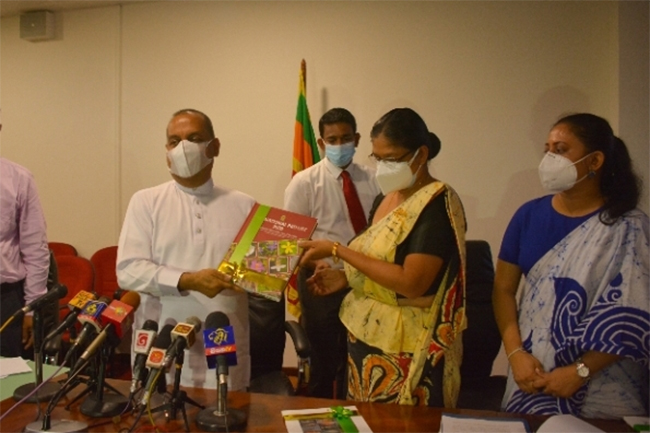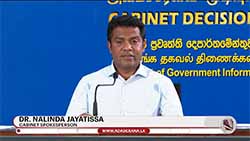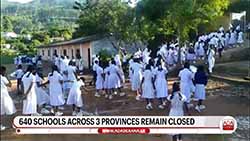National Red List of Flora and Freshwater Fish 2020 published
September 4, 2021 07:47 pm
The Ministry of Environment has published the updated National Red List of Flora and Freshwater Fisheries for the year 2020.
The two publications were unveiled during a virtual even held on Friday (Sep. 03), chaired by Environment Minister Mahinda Amaraweera. Secretary to the Environment Ministry Dr. Anil Jasinghe and Prof. Devaka Weerakoon, Prof. Cyril Wijesundera and Dr. Subhani Ranasinghe of the University of Colombo also took part in the event.
The National Red List 2020 on Flora is prepared with coordination of the Biodiversity Secretariat of the Ministry of Environment and the main technical contribution of the National Herbarium of the Department of National Botanic Gardens including participation of an advisory group and a team of experts.
The book includes national conservation status of plant species, especially flowering plants (Angiosperm), Ferns and Lycophytes (Pteridophyte) in Sri Lanka. In addition to those, checklists of Cryptogamic Flora (non- seed bearing plants: Algae, Lichens, Bryophytes and ferns) and Fungi of Sri Lanka also included in the 2020 Red List.
Threatened statuses of taxa were evaluated using standard guidelines published by the International Union for Conservation of Nature (IUCN). Data compilation, preparation of maps and assessments on Angiosperms were carried out by the Red Listing Team of the National Herbarium and presented to the expert group for final evaluation. During this effort, nomenclature for Angiosperm Plant families and species were also updated with taxonomic and nomenclatural expertise.
The National Red List 2020 evaluated a total number of 3,087 flowering plant species from 186 plant families. The present number of endemic flowering plant species is 863 (28% of total angiosperm flora).
The last list compiled in 2012 contained a total of 3154 species, however during the current red listing process, it was observed that 131 species in the 2012 list needed to be removed since they were either naturalized exotics, misidentifications or those species previously considered as cosmopolitan which are now being recognized for their real natural distribution, which is outside Sri Lanka. The current red list includes 64 species that were not included in the 2012 National Red List. Among them, 210 are new species described since the publication of the National Red List 2012. The other 49 indigenous species were overlooked as they were not included in the Flora of Sri Lanka.
In the 2012 Red list five species were listed as extinct. Three of these species, Rinorea decora
(Violaceae), Rinorea bengalensis and Crudia zeylanica (Fabaceae), were recollected during botanical surveys conducted after 2012. Therefore, only two species are now believed to be extinct. These extinct species are Strobilanthesc audata (Acanthaceae), and Blumea angustifolia (Asteraceae). Doona ovalifolia (Dipterocarpaceae) and Alphonsia hortensis (Annonaceae) were listed under the Extinct in the Wild Category (EW) in the 2012 Red List (MOE, 2012). Eugenia xanthocarpa (Myrtaceae) is added to the EW category in the current list. Alphonsea hortensisand Eugenia xanthocarpa are presently cultivated at Royal Botanic Gardens-Peradeniya.
Among the of 3,087 flowering plant species evaluated, 1,496 are threatened (critically endangered, endangered or vulnerable). This is about 48.4% of the total angiosperm flora in Sri Lanka. Distribution of threatened species shows that highest numbers of threatened species are found in wet zone districts such as Kandy, Ratnapura, Nuwara Eliya, Badulla, Matale, Galle and Kalutara. These districts also house the largest diversity of angiosperm species.
The National Red List of ferns and fern allies 2020 was compiled by team of scientists based on their expert knowledge and the specimen collection at the National Herbarium. That List contains 350 species including 42 endemics of which 207 species (59% of total species) were recorded as threatened.
Threats to the indigenous flora may range from direct causes such as habitat loss and environmental pollution to indirect factors such as unavailability of pollinators or dispersal agents. Whatever, the causal factors there may be, the proportion of threatened angiosperm plant species is exceedingly high. Therefore, findings of the Red List need to be paid more serious attention without delay by all concerned.
The Environment Ministry says the Sri Lankan freshwater fish, especially endemic species are underrepresented in the global Red List. For instance, up to 2019, global IUCN Red List carried the threat status of 54 species present in Sri Lanka, including only 18 out of the 62 endemic species listed for Sri Lanka in 2019. Out of the 18 endemic species only eight has been listed as threatened species. Further, more than 20 species of endemic species of fish were not even recognised as valid species in the global Red List database. Therefore, one of the objectives of this assessment was to update the global Red List with respect to endemic freshwater fish of Sri Lanka. As a result of the present assessment the threat status of 59 out of the 61 species were updated in the global Red List. The remaining two species were not updated due to taxonomic uncertainties.
The last national assessment of the freshwater fish was carried out in 2012, by the Biodiversity Secretariat of the then Ministry of Environment — with inputs from a freshwater expert panel — using Red List criteria version 3.1. Ninety-one species, including 50 endemic species were assessed. Of the 50 endemics considered, 45 were listed as Nationally Threatened. However, the Red List is a living document that must be updated regularly as the drivers and pressures on species as well as taxonomic status, distribution status as well as the available information are subject to change with time. For instance, since the last national assessment in 2012, 14 new species including 11 endemics have been added to the freshwater fish list while four species have been removed. Therefore, this assessment was undertaken, using the IUCN Global Red List criteria (version 3.1), to determine the current threat status of freshwater fish species both endemic and indigenous to Sri Lanka. The completed data from this assessment were used to update the global Red List website (www:redlist.org) as well as finalise the National Red List threat status of the freshwater fish in Sri Lanka.
The freshwater fish checklist published in the National Red List (2012) was updated using all published information since 2012 on newly described species, changes in genus or species name based on taxonomic reviews, species that have been removed from list of freshwater species list or synonymized based on published taxonomic reviews.
This new list was reviewed and adopted at a meeting of the National Freshwater Fish Expert Panel held at the Biodiversity Secretariat. Ninety-seven freshwater fish species, including 61 species, endemic to Sri Lanka were assessed using the IUCN Red List categories and criteria version 3.1 (IUCN, 2012) and the most appropriate threat status was assigned to each species. Thirty exotic species were not considered in this assessment.
Fifty-three out of 97 assessed species were determined to be threatened during this assessment. Further, 74% - nearly three quarters - of the freshwater fish endemic to Sri Lanka were found to be threatened. Out of the 60-endemic species, 12-point endemic species were listed as Critically Endangered (CR); 24 range-restricted species were listed as Endangered (EN) while further nine species were listed as Vulnerable (VU). In addition, five species were listed as Near Threatened (NT); two species as Data Deficient (DD); and the remaining species were listed as Least Concern (LC). Among the native species (36) were also assessed and out of these, eight species were listed as Threatened.












